In natural conversations, it is very common that a user provides background / relevant information while describing a specific scenario. Traits are specific entities, attributes or details that the users express in their conversations. The utterance may not directly convey any specific intent, but the traits present in the utterance can be used in driving the intent detection and bot conversation flows.
For example, the utterance ‘my card is being rejected and am on a business trip’ expresses two traits ‘card decline’ and ‘emergency’. In this scenario, the utterance does not convey any direct intent or at best it can be used to trigger the ‘unblock card’ flow. However, the presence of ‘emergency’ trait can be used to directly assign the conversation to a human agent.
Traits feature of the Bots platform is aimed at identifying such characteristics present in user utterances and use them for intent detection and in customizing the bot definition using these characteristics.
Use Case
Book a Flight bot might have an added requirement to book a flight based on the cost preference.
User utterance: ‘I am looking for a low cost option to London’ should result in ordering the available flights and picking the lowest priced ticket.
This can be achieved by:
- adding a Trait Type called Travel Class with Trait Economy trained with the utterance “low cost”
- adding a Rule for “book flight” to be triggered in the presence of Economy Trait
- add transition condition in case Trait Economy is present in the context
Configuration
Configuring Traits involves:
- Trait Definition
- Trait Association Rules
- Trait Detection
Trait Definition
Traits can be defined from the Traits section under Natural Language -> Training.
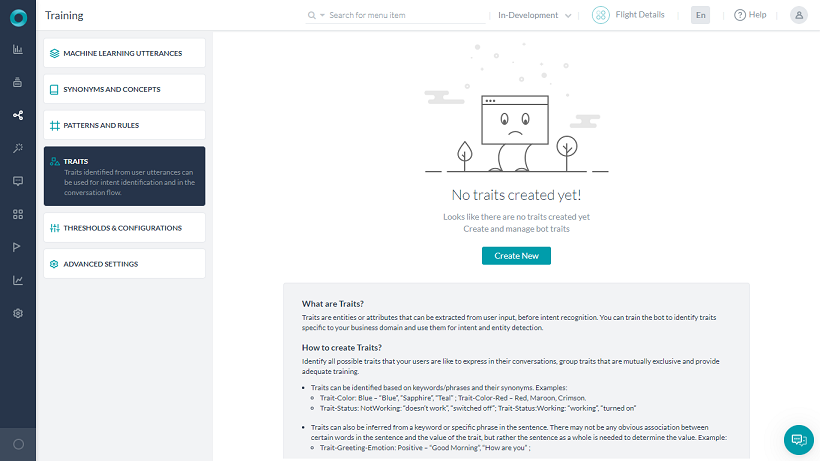
Following are the key features to be considered while defining Traits:
- Trait Type will be a collection of related traits like Travel Class in the above example.
- Trait Type can be ‘ML Based‘ or ‘Pattern Based‘. Each trait of a trait type can be trained using words, phrases, utterances or patterns based on the type. Manage Trait Type allows you to define the training configuration.
-
- ML-based trait types can be configured to set the ML threshold value between 0 and 1.
-
- A Trait Type can have one or more Traits.
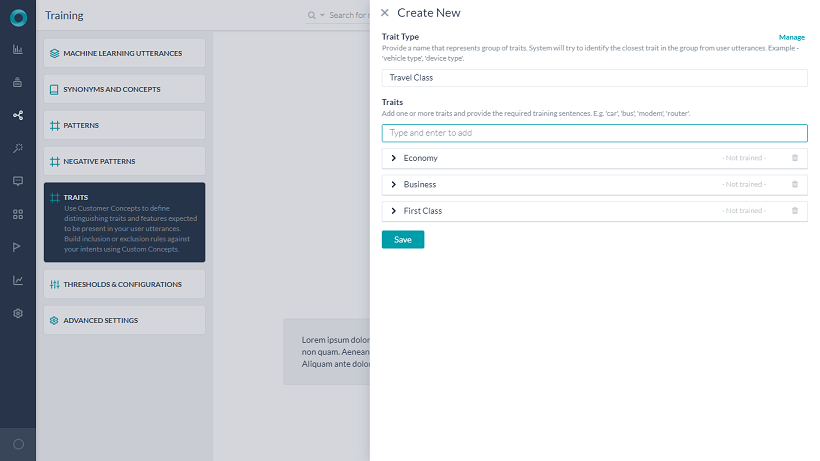
- Traits name should be unique in a group. But trait with the same name can be present in multiple groups.
- For ML-based Traits, you can define the words, phrases or utterances that identify the trait. One trait per trait type will be detected for ML-based trait types.
- For Pattern-based Traits, you get to define the patterns associated with the given trait. There is a possibility of multiple traits getting detected for pattern-based trait types. Ordering of Traits within the Trait Type signifies the importance of a trait in a trait type and detect only one trait.
- Once added, Train the Bot for the Traits to be detected from user utterances.
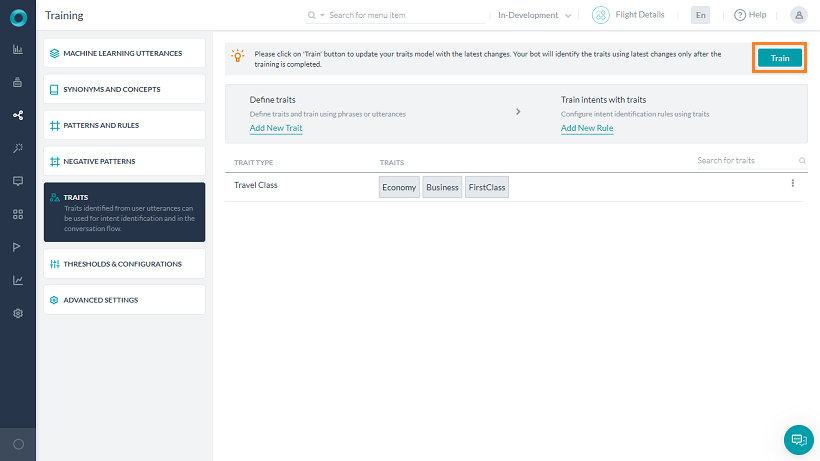
Notes:
- You can add language specific traits in case of multi-lingual Bots.
- When a trait name is modified, ensure that all the rules defined using that trait are corrected. This has to be done manually, the platform will not take care of it.
- Trait name should be unique in a group.
- Traits with the same name can be present in multiple groups, but distinguishing them in trait rules or trait detection results would be difficult.
Trait Association Rules
Trait Rules define Dialog Execution and Knowledge Graph Intent detection.
Dialog Execution
Intent detection or Dialog execution can be achieved using traits, along with the ML utterances and patterns. To achieve this, an intent needs to be associated with the required traits by adding Rules.
There are multiple ways to add rules:
- From the Traits section using the Add New Rule link

- From the Intent Node using the Rules section under the NLP Properties
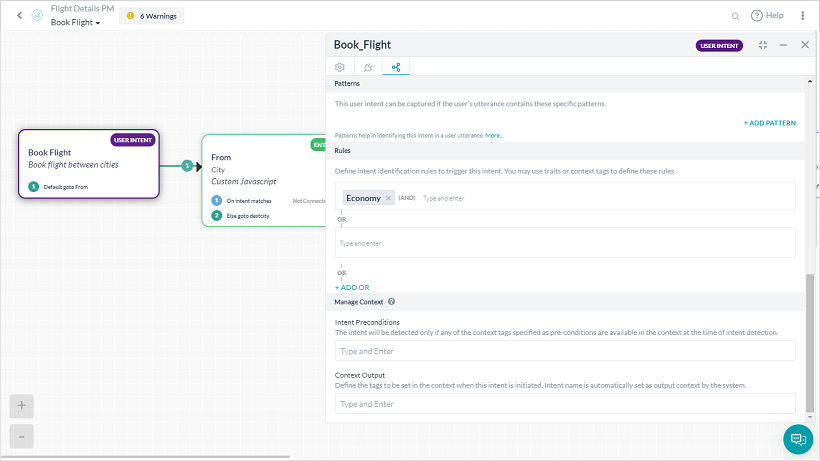
- From the Patterns and Rules section using the Rules tab for a given Intent.

Each rule can have one or more conditions with AND as the operator. Multiple trait rules can be defined for a given intent and the intent will be considered as a definite match if any one of the rules matches.
Knowledge Graph Intents
Knowledge Graph can also be part of the discovery process using Traits. For this, each term or node can be associated with a trait. A given term can be associated with a single Trait.
NOTE: Traits will replace the Classes from releases 6.4 and previous.
Trait Detection
Only one trait from a group (trait type) will be detected and will be considered as a ‘definite match’.
Traits detected are included in the context object. The context will be populated with unique traits identified (without reference to trait type). This information can be used in:
- intent identification
- dialog transition
- entity population
- bot definitions
Batch Testing reports also include information about traits detected as do the Find Intent API.
Intent Detection
The Ranking and Resolver gets input from the three NL engines and Traits to analyze and come up with the possible/definitive matches.
- The intent will be considered as ‘definite match’ only if all the traits (one in case of Knowledge Graph) present in a trait rule are detected.
- NL Analysis will include information on traits detected and the NLP Flow will show the information about traits detected.
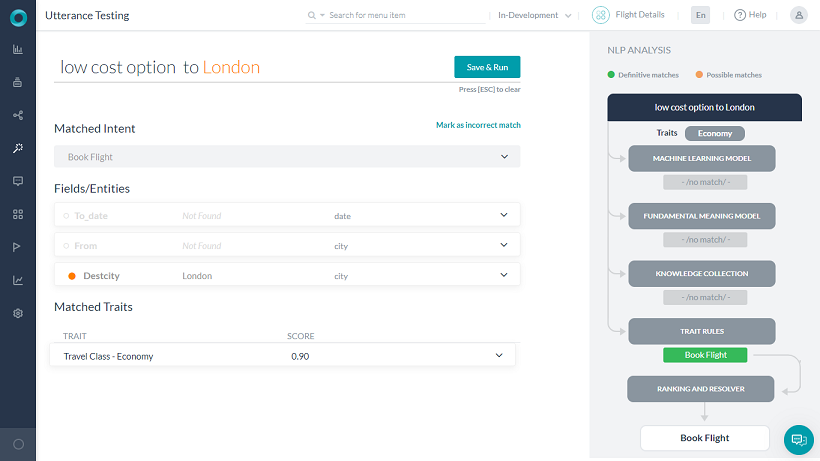
Dialog Transition
Conversation Flow can be controlled using Traits. For a Dialog, Connection Rules can be defined using the Trait Context. This can be done from the Connection tab under the Properties Panel for the Dialog.
The Traits Context can be accessed using context.traits. It returns an array of all traits matching the intent, hence the condition to be used would be contains.



